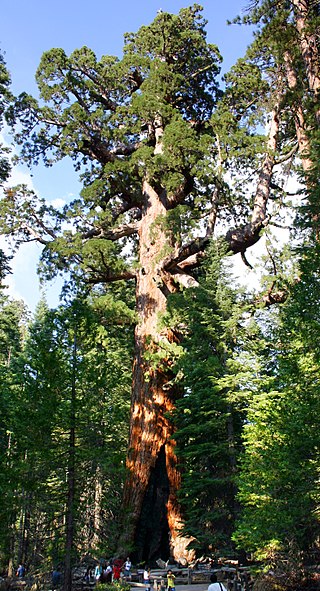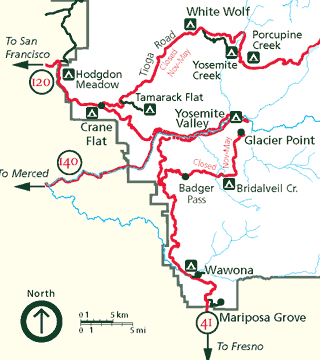
Yosemite National Park is a national park in California. It is bordered on the southeast by Sierra National Forest and on the northwest by Stanislaus National Forest. The park is managed by the National Park Service and covers 759,620 acres in four counties – centered in Tuolumne and Mariposa, extending north and east to Mono and south to Madera. Designated a World Heritage Site in 1984, Yosemite is internationally recognized for its granite cliffs, waterfalls, clear streams, giant sequoia groves, lakes, mountains, meadows, glaciers, and biological diversity. Almost 95 percent of the park is designated wilderness. Yosemite is one of the largest and least fragmented habitat blocks in the Sierra Nevada.

Sequoiadendron giganteum, also known as the giant sequoia, giant redwood or Sierra redwood is a coniferous tree, classified in the family Cupressaceae in the subfamily Sequoioideae. Giant sequoia specimens are the most massive trees on Earth. They are native to the groves on the western slopes of the Sierra Nevada mountain range of California but are grown around the world.

Kings Canyon National Park is an American national park in the southern Sierra Nevada, in Fresno and Tulare Counties, California. Originally established in 1890 as General Grant National Park, the park was greatly expanded and renamed on March 4, 1940. The park's namesake, Kings Canyon, is a rugged glacier-carved valley more than a mile (1,600 m) deep. Other natural features include multiple 14,000-foot (4,300 m) peaks, high mountain meadows, swift-flowing rivers, and some of the world's largest stands of giant sequoia trees. Kings Canyon is north of and contiguous with Sequoia National Park, and both parks are jointly administered by the National Park Service as the Sequoia and Kings Canyon National Parks.

General Sherman is a giant sequoia tree located at an elevation of 2,109 m (6,919 ft) above sea level in the Giant Forest of Sequoia National Park in Tulare County, in the U.S. state of California. By volume, it is the largest known living single-stem tree on Earth.

Calaveras Big Trees State Park is a state park of California, United States, preserving two groves of giant sequoia trees. It is located 4 miles (6.4 km) northeast of Arnold, California in the middle elevations of the Sierra Nevada. It has been a major tourist attraction since 1852, when the existence of the trees was first widely reported, and is considered the longest continuously operated tourist facility in California.

The Giant Sequoia National Monument is a 328,000-acre (512 sq mi) U.S. National Monument located in the southern Sierra Nevada in eastern central California. It is administered by the U.S. Forest Service as part of the Sequoia National Forest and includes 38 of the 39 Giant Sequoia groves that are located in the Sequoia National Forest, about half of the sequoia groves currently in existence, including one of the ten largest Giant Sequoias, the Boole Tree, which is 269 feet (82 m) high with a base circumference of 112 feet (34 m). The forest covers 824 square miles (2,130 km2).

Mariposa Grove is a sequoia grove located near Wawona, California, United States, in the southernmost part of Yosemite National Park. It is the largest grove of giant sequoias in the park, with several hundred mature examples of the tree. Two of its trees are among the 30 largest giant sequoias in the world.

Sequoia National Forest is located in the southern Sierra Nevada mountains of California. The U.S. National Forest is named for the majestic Giant Sequoia trees which populate 38 distinct groves within the boundaries of the forest.

Tahoe National Forest is a United States National Forest located in California, northwest of Lake Tahoe. It includes the 8,587-foot (2,617 m) peak of Sierra Buttes, near Sierra City, which has views of Mount Lassen and Mount Shasta. It is located in parts of six counties: Sierra, Placer, Nevada, Yuba, Plumas and El Dorado. The forest has a total area of 871,495 acres. Its headquarters is in Nevada City, California. There are local ranger district offices in Camptonville, Foresthill, Sierraville and Truckee.

The Wawona Tree, also known as the Wawona Tunnel Tree, was a famous giant sequoia that stood in Mariposa Grove, Yosemite National Park, California, United States, until February 1969. It had a height of 227 feet (69 m) and was 26 feet (7.9 m) in diameter at the base.

Converse Basin Grove is a grove of giant sequoia trees in the Giant Sequoia National Monument in the Sierra Nevada, in Fresno County, California, 5 miles (8 km) north of General Grant Grove, just outside Kings Canyon National Park. Once home to the second-largest population of giant sequoias in the world, covering 4,600 acres (19 km2) acres, the grove was extensively logged by the Sanger Lumber Company at the turn of the 20th century. The clearcutting of 8,000 giant sequoias, many of which were over 2,000 years old, resulted in the destruction of the old-growth forest ecosystem.

Mountain Home Grove is a grove of giant sequoia trees located in the southern part of the Sierra Nevada Mountains of California, and includes some of the largest trees in the world.

The Sierra Nevada lower montane forest is a plant community along a strip along the western and eastern edges of the Sierra Nevada mountain range in California. This zone is also known as a yellow pine forest.

The Pioneer Cabin Tree, also known as The Tunnel Tree, was a giant sequoia in Calaveras Big Trees State Park, California. It was considered one of the U.S.'s most famous trees, and drew thousands of visitors annually. It was estimated to have been more than 1,000 years old, and measured 33 feet (10 m) in diameter; its exact age and height were not known. The tree was topped before 1859. It fell and shattered during a storm on January 8, 2017.
The protected areas of the Sierra Nevada, a major mountain range located in the U.S. states of California and Nevada, are numerous and highly diverse. Like the mountain range itself, these areas span hundreds of miles along the length of the range, and over 14,000 feet of elevation from the lowest foothills to the summit of Mount Whitney.

The Forest King was a giant sequoia tree located in Nelder Grove, California that was cut down in 1870 and taken on a touring exhibit in the United States. This tree was the first of its kind to be felled for exhibition, unlike earlier trees such as the Mother of the Forest from Calaveras Grove where only bark was removed. This act sparked public outcry and would lead to the founding of national parks and the protection of giant sequoias through the nascent conservation movement.

The Discovery Tree, also known as The Mammoth Tree was a Sequoiadendron giganteum tree located in Calaveras Grove, California. In 1852, A.T. Dowd found a grove in the Sierra Nevada; the trees in the grove were believed to be the first giant sequoia trees to be discovered, though some earlier reports of giant sequoias were reported.The trees he discovered included the Discovery Tree, with a height of 300 feet high and a base measuring over 24 feet in diameter.The Discovery Tree was cut down and shipped to San Francisco and New York City for exhibition. The tree played a large role in the introduction of the Yosemite Grant to Congress, an act that helped preserve the giant sequoias. The stump of the Discovery Tree is a popular attraction in Calaveras Grove, which has about 200,000 visitors each year.




















